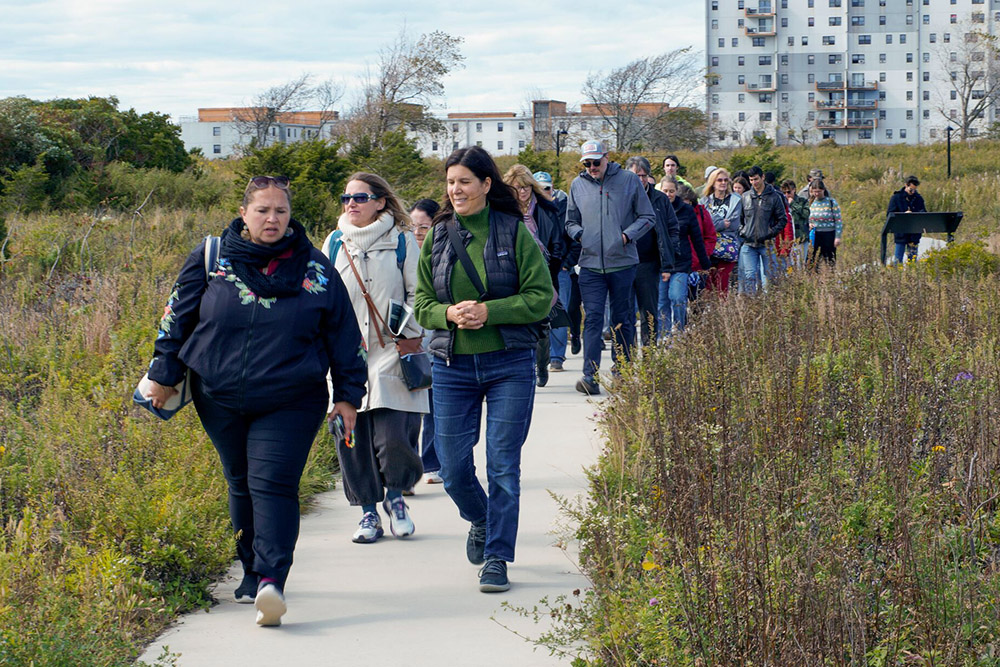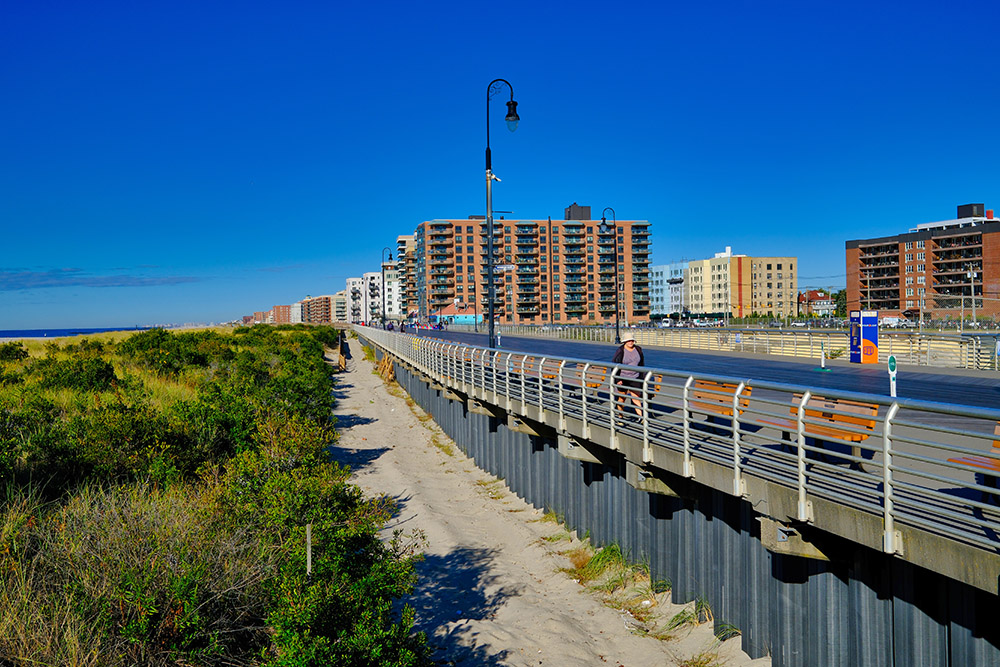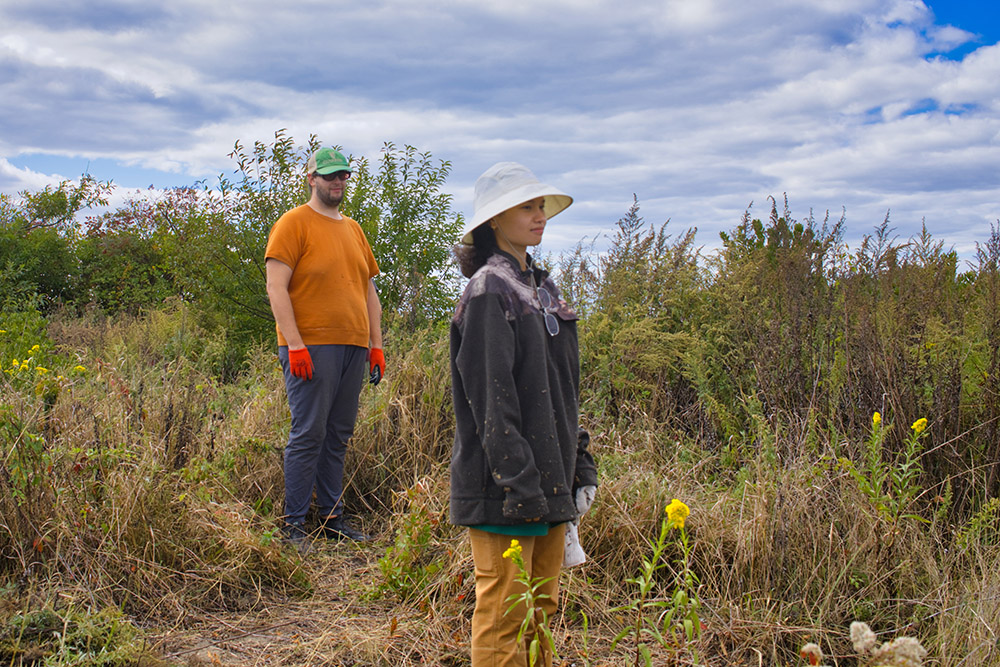 A Collaborative for the Earth field trip to the Rockaways explored how students and faculty might study how the community was able to rebuild with engineering and nature-based infrastructure after the destruction from Superstorm Sandy in 2012. Photo by J.D. Allen.
A Collaborative for the Earth field trip to the Rockaways explored how students and faculty might study how the community was able to rebuild with engineering and nature-based infrastructure after the destruction from Superstorm Sandy in 2012. Photo by J.D. Allen.
More than 35 Stony Brook University faculty, students, and staff ventured to Long Island’s Atlantic coast to examine firsthand how communities are rebuilding and adapting in the wake of climate challenges. The field trip to Long Beach and the Rockaways provided an up-close look at innovative infrastructure projects, coastal engineering efforts, and community-centered development that are reshaping these vulnerable shoreline communities.
Long Beach, a barrier island city of approximately 33,000 residents, bore the brunt of Superstorm Sandy in 2012. More than a decade later, the city has emerged as a living laboratory for coastal resilience, said Heather Lynch, director of Stony Brook’s Collaborative for the Earth (C4E). The team explored two major infrastructure initiatives that are fundamentally transforming how the community protects itself against future storms and flooding.
 Photo by Jeffrey S. Levinton.
Photo by Jeffrey S. Levinton.
The Bay Park Conveyance Project represents one of the most significant wastewater infrastructure improvements in the region’s history. Meanwhile, a critical infrastructure project addresses the city’s vulnerable utilities and services. Both initiatives reflect a comprehensive approach to climate adaptation that goes far beyond simply rebuilding what was lost.
“These are more than just engineering projects,” said Lynch, who also serves as the endowed chair for ecology and evolution in the Institute for Advanced Computation Science (IACS). “They’re about reimagining how coastal communities can survive and thrive in an era of rising seas and intensifying storms.”
The team also visited RISE Rockaway in Far Rockaway, where L&M Development Partners has created a mixed-use development that integrates affordable housing, retail space, and community amenities. The project represents a new model for post-disaster recovery that prioritizes both physical resilience and social equity.
Walking along the restored upper beach — planted with native grasses and other species — students and faculty could observe how these nature-based solutions work together to reduce erosion and provide storm surge protection while maintaining recreational access. They compared the approach to the U.S. Army Corps of Engineers beach engineering project, which reinforced the lower beach with millions of cubic yards of sand along the shoreline.
 Photo by Jeffrey S. Levinton.
Photo by Jeffrey S. Levinton.
The interdisciplinary nature of the field trip reflected the complex challenges these communities face. Urban planning students considered how development patterns affect vulnerability. Environmental science students assessed the ecological impacts of coastal armoring. Artists and social scientists explored how communities maintain their identity and cohesion through restorative change.
Adam Charboneau, a lecturer in the School of Marine and Atmospheric Sciences, said there was immense value in experiencing these projects firsthand. “First and foremost, you see people in action, so it’s not just an idea,” he said. “It’s real people doing real things in their communities. You also see all the nuances that don’t come through in classroom discussions.”
Chabaneau also highlighted how the trip illustrated core concepts in sustainability planning. “One thing we always focus on in sustainability or sustainable planning are these three ‘Es’ or three pillars: economic growth, environmental health, and equity and fairness,” he said. “Those things are hard to align, right? Because they’re often in conflict, and you see ways in which community groups are trying to navigate those conflicts to some greater alignment.”
He pointed to Long Beach’s dune system as an example: it protects environmental health and increases property values, giving residents more disposable income to support local businesses, but might create unpleasant aesthetics for some community members with high dunes and nearby elevated structures blocking the view to the Atlantic. “You see these trade-offs playing out in real time,” he added.
His student, sustainability major Akshay Illiparambil, was struck by the scale of the challenges. “You can design the perfect system on paper, but when you see the actual coastline and understand the community dynamics, you realize how many variables you have to account for,” he said.
The trip to Long Beach and the Rockaways also highlighted ongoing debates about coastal adaptation strategies. Should communities rely primarily on hard infrastructure like seawalls, or embrace nature-based solutions? How do you balance protection with maintaining beach access and ocean views? What happens to communities that can’t afford these massive infrastructure investments?
More than a dozen academic departments were represented on the trip, from art and sociology to atmospheric sciences and public policy.
 Photo by J.D. Allen.
Photo by J.D. Allen.
Manisha Desai, executive director of the Center for Changing Systems of Power and professor in the Departments of Sociology and Women’s, Gender, and Sexuality Studies, said addressing climate adaptation requires breaking down academic silos: “Engineers need to understand social dynamics. Social scientists need to grasp technical constraints. Everyone needs to think about equity and justice.”
The C4E field trip is the latest in Stony Brook’s commitment to climate research and education, positioning the university as a leader in preparing the next generation of professionals who will design, build, and manage resilient coastal communities.
“These aren’t distant, abstract problems. They’re unfolding right now, just miles from Stony Brook, in communities where real people are making difficult decisions about their future,” Lynch said.
